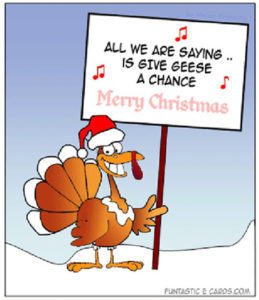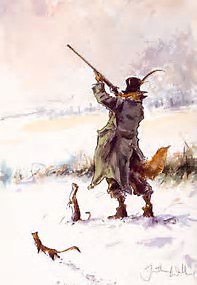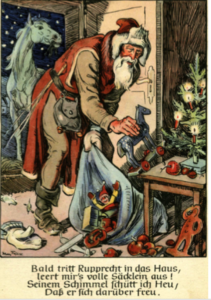The most widely-served Christmas entrée today is the turkey, Meleagris gallopavo, a bird first domesticated in Mexico by the Aztecs and exported to Europe in the sixteenth century by the Spanish. It derives its English name from confusion with the guinea fowl which was imported about the same time by merchants trading with Turkey. William Strickland, a Yorkshireman, introduced the bird into England and, in recognition, was granted a turkey cock on his family coat of arms in 1550. Before too long it was accepted as a seasonal dish: Thomas Tusser in 1573 speaks of it as “Christmas husbandlie fare” but for centuries the goose remained the primary Christmas bird. The bird was raised in great numbers on farms in Norfolk and East Anglia with huge flocks driven to market in London every Christmas — walking on the roads was difficult for the birds who were fitted with special shoes for the journey which could last as long as three months. It was not until the nineteenth century with the advent of rail travel and refrigeration that these drives ceased and were replaced by slaughtering on the farm. In 1851 the British royal family ate their first Christmas turkey which from that time on replaced swan as the seasonal dish.
Americans are the world’s greatest consumers of turkeys since the two great end-of-year festivals, Thanksgiving and Christmas, both feature the fowl whom Benjamin Franklin wanted to make the national bird of the United States — he deplored the bald eagle’s “bad moral character” and claimed the turkey was a “much more respectable bird, and withal a true original native of America.” Since 1947, the National Turkey Federation has presented the President of the United States with a live turkey and two dressed birds at Thanksgiving. The annual presentation signals the unofficial beginning of the “holiday season”; after the ceremony, the National Thanksgiving Turkey retires to a historical farm to spend its declining years in comfort.
The bird is eaten all around the world. In Portugal poultry farmers walk the streets of Lisbon with their their flocks. When a buyer has chosen the turkey he wants, the farmer catches the bird, forces alcohol into it, and briefly releases it. The inebriated turkey soon collapses; its throat is then slit; it is plucked and eviscerated, before being soaked in salt water, perfumed with lemon and bay leaves, for twelve hours. The bird is then hung for twelve hours before being cooked. The Brazilians have a similar love of turkey tenderized from within: they feed the bird a kind of rum called cachaça on Christmas Eve. In the southern United States the custom of deep-frying the bird is growing while in Mexico they eat the bird with a sauce made of chocolate and chili peppers. In Spain they stuff the bird with truffles; in Burgundy they stuff it with chestnuts. In 1969 the Apollo astronauts’ first meal on the moon was roast turkey.




